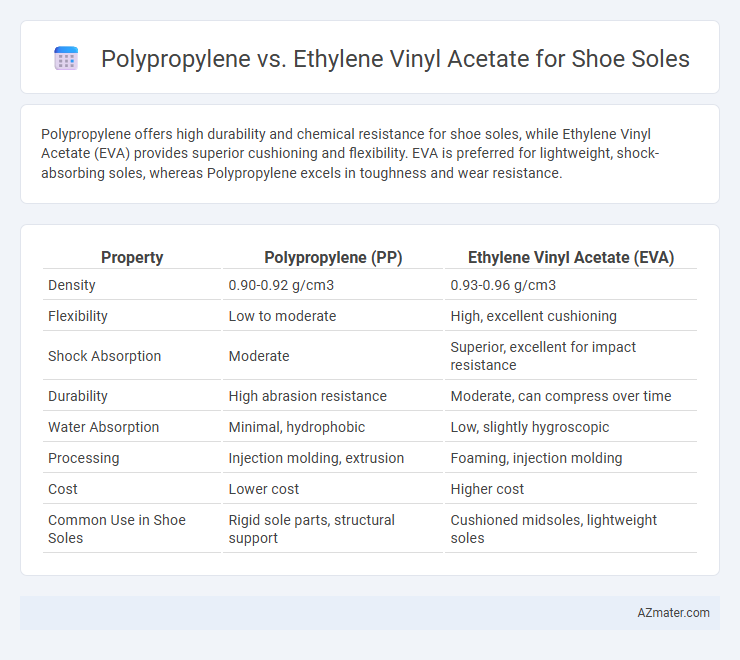Polypropylene offers high durability and chemical resistance for shoe soles, while Ethylene Vinyl Acetate (EVA) provides superior cushioning and flexibility. EVA is preferred for lightweight, shock-absorbing soles, whereas Polypropylene excels in toughness and wear resistance.
Table of Comparison
| Property | Polypropylene (PP) | Ethylene Vinyl Acetate (EVA) |
|---|---|---|
| Density | 0.90-0.92 g/cm3 | 0.93-0.96 g/cm3 |
| Flexibility | Low to moderate | High, excellent cushioning |
| Shock Absorption | Moderate | Superior, excellent for impact resistance |
| Durability | High abrasion resistance | Moderate, can compress over time |
| Water Absorption | Minimal, hydrophobic | Low, slightly hygroscopic |
| Processing | Injection molding, extrusion | Foaming, injection molding |
| Cost | Lower cost | Higher cost |
| Common Use in Shoe Soles | Rigid sole parts, structural support | Cushioned midsoles, lightweight soles |
Introduction to Shoe Sole Materials
Polypropylene and Ethylene Vinyl Acetate (EVA) are widely used polymers in shoe sole manufacturing, each offering distinct physical properties that impact comfort and durability. Polypropylene is known for its rigidity, chemical resistance, and lightweight nature, making it suitable for durable and cost-effective soles. In contrast, EVA provides superior cushioning, flexibility, and shock absorption, enhancing wearer comfort in athletic and casual footwear applications.
Overview of Polypropylene (PP) in Footwear
Polypropylene (PP) is widely used in footwear for its lightweight, durable, and moisture-resistant properties, making it ideal for shoe soles that require long-lasting performance. Its high resistance to abrasion and chemical exposure ensures enhanced durability and comfort during prolonged wear. Polypropylene's cost-effectiveness and ease of molding contribute to its popularity in producing flexible, supportive, and impact-absorbing shoe soles.
Ethylene Vinyl Acetate (EVA): Material Profile
Ethylene Vinyl Acetate (EVA) is a lightweight, flexible polymer widely used in shoe soles for its excellent shock absorption and cushioning properties. Its superior elasticity and durability provide enhanced comfort and resilience compared to polypropylene, which tends to be stiffer and less impact-resistant. EVA's chemical composition, combining ethylene and vinyl acetate, allows for customization of hardness and density, making it ideal for various footwear applications requiring balance between support and flexibility.
Mechanical Properties: PP vs EVA
Polypropylene (PP) exhibits higher tensile strength and rigidity compared to Ethylene Vinyl Acetate (EVA), making it suitable for durable and load-bearing shoe soles. EVA offers superior flexibility, shock absorption, and cushioning due to its lower density and elastomeric nature, enhancing comfort and impact resistance. The choice between PP and EVA depends on the desired balance between mechanical strength and cushioning performance in footwear applications.
Comfort and Cushioning Comparison
Polypropylene offers excellent rigidity and durability but lacks the softness required for optimal shoe sole comfort and cushioning. Ethylene vinyl acetate (EVA) provides superior shock absorption and flexibility, enhancing overall foot comfort by reducing impact during walking or running. EVA's lightweight and resilient properties make it the preferred material for cushioning in athletic and casual footwear applications.
Durability and Wear Resistance
Polypropylene offers high durability and excellent wear resistance, making it suitable for shoe soles exposed to rough surfaces and heavy usage. Ethylene vinyl acetate (EVA) provides superior flexibility and shock absorption but generally exhibits lower wear resistance compared to polypropylene. For applications demanding long-term abrasion resistance and structural integrity, polypropylene remains the preferred material.
Weight and Flexibility Differences
Polypropylene shoe soles are significantly lighter, typically weighing 0.85 grams per cubic centimeter, compared to Ethylene Vinyl Acetate (EVA), which weighs around 0.93 grams per cubic centimeter, making EVA soles slightly heavier. EVA exhibits superior flexibility due to its elastomeric properties, providing enhanced cushioning and better energy absorption ideal for athletic shoes, whereas polypropylene offers greater rigidity but reduced flexibility. The weight advantage of polypropylene suits designs requiring durability with minimal bulk, while EVA's flexibility supports comfort and shock absorption in lightweight footwear.
Cost Effectiveness for Manufacturers
Polypropylene offers manufacturers a highly cost-effective option for shoe soles due to its low raw material price and ease of processing, which reduces overall production expenses. Ethylene vinyl acetate (EVA), while providing superior cushioning and flexibility, generally incurs higher costs because of more complex compounding and slower processing times. Manufacturers focusing on budget-sensitive production lines often prefer polypropylene to maximize profit margins without compromising basic durability.
Environmental Impact and Sustainability
Polypropylene shoe soles exhibit lower biodegradability and recycling challenges compared to Ethylene Vinyl Acetate (EVA), which can be more easily processed in recycling systems and sometimes sourced with bio-based content. EVA materials typically demonstrate better environmental profiles due to their flexibility, reduced carbon footprint during manufacturing, and potential for improved energy recovery through incineration with energy capture. Selecting EVA over polypropylene for shoe soles often results in enhanced sustainability metrics, including reduced reliance on fossil fuels and minimized long-term landfill persistence.
Best Applications: Choosing PP or EVA for Shoe Soles
Polypropylene (PP) offers excellent rigidity and chemical resistance, making it ideal for hard-wearing shoe soles used in industrial or outdoor footwear. Ethylene vinyl acetate (EVA) provides superior cushioning, flexibility, and shock absorption, making it the preferred choice for athletic and casual shoe soles focused on comfort and impact resistance. Selecting between PP and EVA depends on desired sole characteristics: durability and structural support favor PP, while lightweight comfort and flexibility prioritize EVA.

Infographic: Polypropylene vs Ethylene vinyl acetate for Shoe sole
 azmater.com
azmater.com